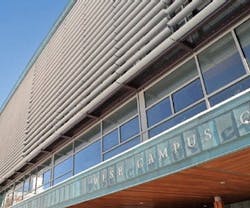Reducing the amount of solar energy will lessen the amount of air conditioning needed to battle the rising temperature associated with solar energy entering your building, as well as lessen the number of complaints you receive about the sun’s rays causing glare on computer screens and other surfaces. External shades can be your solution.
There are many benefits to implementing an external shading system. “A well-designed exterior shading system can significantly reduce the solar gains entering the building,” says Richard Wilson, director of Nysan Solar Control’s Advanced Technology Group. “As a result, the size of the HVAC system can be reduced, generating savings to offset against the cost of the shading system, and creating further savings from reduced running costs. If the shading system is optimizing the use of natural daylight, significant savings in artificial lighting costs can be achieved, particularly if dimmable ballast lighting systems are used.”
In addition, well-designed systems will provide a more comfortable working environment, as people can work closer to the glazing without significant heat problems and have better access to natural daylight.
Don't concentrate solely on the benefits – there are considerations to make before installing an external shading system.
Orientation-Centric Solutions
The orientation of your building influences which shading options are best suited for it. Choose the shading solution that will have the most impact on each side of your building.
“Traditionally, a fixed overhang is your best bet for the south elevation while fixed vertical fins have advantages for east- and west-facing facades,” says Davidson Norris, principal with Carpenter Norris Consulting, Inc.
In addition, shading the south-facing portion of your facade is most cost-effective because it receives the most annual solar radiation. Shading the west-facing portion is also very beneficial, as it receives direct gains late in the day when your building’s summer cooling loads (and your electricity costs) are the greatest.
The orientation of your facility is a small-picture consideration when it comes to implementing an external shading solution. Your overall location can have a great impact on the feasibility of this solution. “At a climatic level, the more intense solar radiation bombardment, the more valuable the external shading,” Norris says. “Solar shading in Phoenix is going to be more productive in terms of reduced cooling loads and costs than in Montreal.”
Materials Matter
There’s a multitude of materials when it comes to exterior shading systems. “You can make them out of just about anything,” says Sean O’Brien, associate principal at Simpson Gumpertz & Heger Inc., “but the specifics will depend on the load of the building.”
As explained by Ken Sheehan, principal at Architectural Alliance, external shades can be made out of:
- Aluminum is often preferred for its lightweight construction and durability. It can be prefinished with a 20-30-year finish warranty and is easily integrated into most exterior window systems. Aluminum shades are often shaped into louvers, lattices, or grating.
- Wood louvers provide a natural appearance, although they often require ongoing maintenance and/or replacement. They're typically less dimensionally stable than other alternatives.
- Composite materials provide a good balance between wood and aluminum, but these systems are often custom built.
- Glass shades can be translucent and allow varying percentages of light and views through. They can be easily integrated into most exterior window systems and offer a wide variety of details, colors, and applications.
Select a Shading Solution
When it comes to selecting a system, knowledge is power. “First determine what the performance criteria are that you’re looking for – reduced heat gain, glare control, and visual enhancements,” says Sheehan.
Speak with vendors and learn the combined solar heat gain coefficients (SHGC) that include the SHGC of your glass and that of their shading, recommends Norris. Learning this allows you to directly compare different options.
Enlist the help of a design professional to model the building characteristics, solar exposure, and other parameters of the building to optimize shading locations and size. After a thorough analysis and determination of the correct size, shape, opacity, and extent of the system needed, you can select an appropriate system and materials.
“External shading on its own is typically hard to rationalize economically, as glass coatings and frits can already provide excellent SHGCs at a lower cost,” Norris explains. “But if your sustainability program also calls for daylighting, the combined light redirection and shading function can make external shading, in particular retractable shading, a worthy investment.”
Kylie Wroblaski ([email protected]) is associate editor of BUILDINGS.
